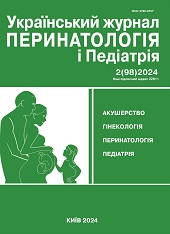Clinical and immunological characteristics of children with primary immunodeficiencies
DOI:
https://doi.org/10.15574/PP.2024.98.70Keywords:
primary immunodeficiency, replacement therapy, children, serum immunoglobulins, lymphocyte subpopulations, bacterial infections, bronchiectasisAbstract
Aim - to study of clinical and immunological indicators in children with primary immunodeficiencies to determine vaccination tactics.
Materials and methods. 51 children with primary immunodeficiency diseases (PID), who made up the main group of the study, were examined. Of the 51 children with PID, 22 children had preserved antibody-forming function, and 29 children had a deficiency of antibody formation, and they received replacement immunoglobulin therapy. Immunological laboratory data (subpopulations of lymphocytes, levels of IgA, IgM and IgG in blood serum) were compared with healthy children in the control group.
Results. Recurrent bacterial infections were most common in children with primary immunodeficiency: otitis media in 34/51 (66.7%), pneumonia in 33/51 (64.7%), bronchitis in 32/51 (62.7%), and sinusitis in 19/51 (37.3%). Bronchiectatic disease occurred in 5 (9.8%) children. Severe invasive infections such as sepsis occurred in 4 (7.8%) children and osteomyelitis in 4 (7.8%) children. In the group of children with PID on immunoglobulin replacement therapy, the levels of serum immunoglobulins IgA (0.798±1.341 g/l), IgM (0.98±1.44 g/l) and IgG (0.99±1.44 g/l) and B-lymphocytes (8.7±7.5%, 302.8±291.1×109/l) were the lowest in comparison with the group of children with PID with preserved or partially preserved function of antibody formation and the control group.
Conclusions. Recurrent bacterial infections are the most common clinical manifestation in children with primary immunodeficiency. Some patients developed bronchiectasis as a result of frequent bacterial infections of the bronchopulmonary system and an untimely diagnosis of antibody deficiency. Timely and appropriate replacement therapy and early correction of antibody deficiency can minimize the progression of many infections and complications in such patients, including vaccine-directed infections. Children with PID with preserved or partially preserved antibody production are expected to have a suboptimal response to primary immunization and require additional doses of vaccine to achieve a long-lasting response to vaccination.
The research was carried out in accordance with the principles of the Declaration of Helsinki. The research protocol was approved by the Institution's Local Ethics Committee. Informed consent of parents and children was obtained for conducting research.
The author declares no conflict of interest.
References
Azizi G, Ahmadi M, Abolhassani H, Yazdani R et al. (2016). Autoimmunity in Primary Antibody Deficiencies. Int Arch Allergy Immunol.171(3-4): 180-193. https://doi.org/10.1159/000453263; PMid:28013299
Bonilla FA, Khan DA, Ballas ZK et al. (2015). Practice parameter for the dagnosis and management of primary immunodeficiency. J Allergy Clin Immunol. 136 (5): 1186-1205.el-78.
Bonilla FA. (2018). Update: Vaccines in primary immunodeficiency. J Allergy Clin Immunol. 141: 474-481. https://doi.org/10.1016/j.jaci.2017.12.980; PMid:29288077
Chernyshova LI. (2007). Problems and achievements of pediatric clinical immunology in Ukraine in 2006. Perinatology and pediatrics. 3(31): 5-6.
Chernyshova LI, Kostyuchenko LV, Romanyshyn YaIu ta in. (2011). Diahnostyka ta vybir terapii u khvorykh iz syndromom Viskota-Oldricha. Sovremennaia pedyatryia. 4: 116-121.
Chernyshova LI, Lapiy FI, Volokha AP (redaktory). (2019). Imunoprofilaktyka infektsiynykh khvorob. 2-e vyd., pererob. Kyiv: VSV Medytsyna: 318.
Chernyshova LI, Volokha AP, Kostyuchenko LV. (2013). Pediatric immunology: a textbook. Kyiv: VSV Medicine: 720.
Liu L, Okada S, Kong XF et al. (2011). Gain-of-function human STAT1 mutations impair IL-17 immunity and underlie chronic mucocutaneous candidiasis. Journal of Experimental Medicine. 208 (8): 1635-1648.
Shah I, Rahangdale A, Bhatnagar S. (2013). Liver Abscesses and Hyper IgM Syndrome. J. Family Med. Prim. Care. 2(2): 206-208. https://doi.org/10.4103/2249-4863.117429; PMid:24479081 PMCid:PMC3894042
Soler-Palacin P, Margareto C, Llobet P et al. (2007). Chronic granulomatous disease in pediatric patients: 25 years of experience. Allergol. Immunopathol. (Madr). 35 (3): 83-89. https://doi.org/10.1157/13106774; PMid:17594870
Subbarayan A, Colarusso G, Hughes SM et al. (2011). Clinical Features That Identify Children With Primary Immunodeficiency Diseases. Pediatrics. 127 (5): 810-816. https://doi.org/10.1542/peds.2010-3680; PMid:21482601
Volokha AP, Boiarchuk OR, Bondarenko AV. (2020). Vaktsynatsiia ditei z pervynnymy imunodefitsytamy. Metodychni rekomendatsii. Kyiv: Znannia.
Yarmohammadi H, Estrella L, Doucette J et al. (2006). Recognizing primary immune deficiency in clinical practice. Clin. Vaccine Immunol. 13(3): 329-332. https://doi.org/10.1128/CVI.13.3.329-332.2006; PMid:16522773 PMCid:PMC1391953
Downloads
Published
Issue
Section
License
Copyright (c) 2024 Ukrainian Journal of Perinatology and Pediatrics

This work is licensed under a Creative Commons Attribution-NonCommercial 4.0 International License.
The policy of the Journal “Ukrainian Journal of Perinatology and Pediatrics” is compatible with the vast majority of funders' of open access and self-archiving policies. The journal provides immediate open access route being convinced that everyone – not only scientists - can benefit from research results, and publishes articles exclusively under open access distribution, with a Creative Commons Attribution-Noncommercial 4.0 international license(СС BY-NC).
Authors transfer the copyright to the Journal “MODERN PEDIATRICS. UKRAINE” when the manuscript is accepted for publication. Authors declare that this manuscript has not been published nor is under simultaneous consideration for publication elsewhere. After publication, the articles become freely available on-line to the public.
Readers have the right to use, distribute, and reproduce articles in any medium, provided the articles and the journal are properly cited.
The use of published materials for commercial purposes is strongly prohibited.

